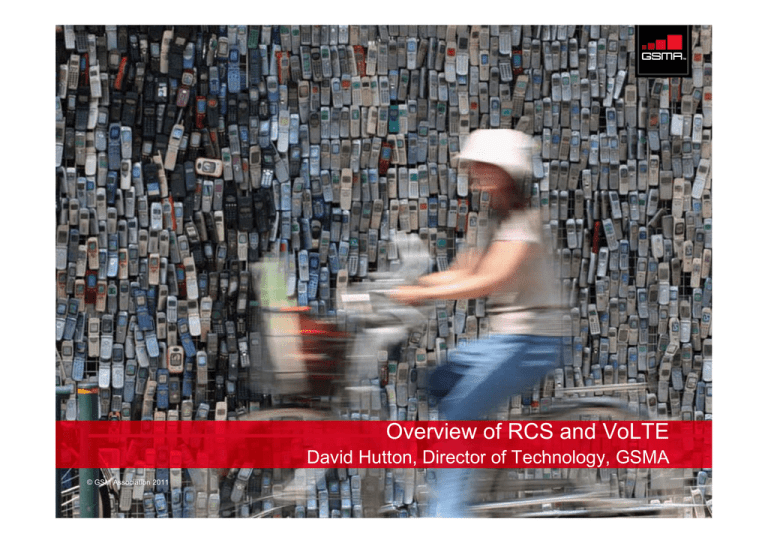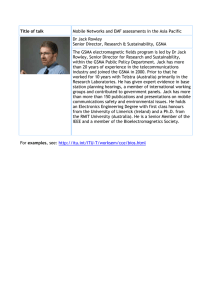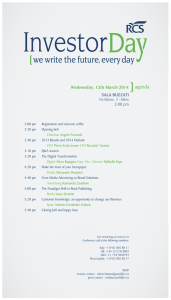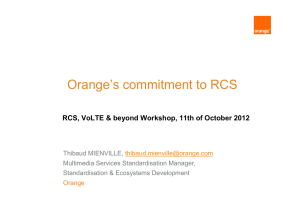Overview of RCS and VoLTE David Hutton Director of Technology GSMA
advertisement

Overview of RCS and VoLTE David Hutton Hutton, Director of Technology Technology, GSMA © GSM Association 2011 The Voice challenge for LTE ■ ■ ■ LTE is an all-IP mobile network – No support for ‘traditional’ CS domain voice Multiple Proposed Technical Solutions – IMS b d V IMS-based Voice i (“O (“One V Voice”) i ”) – CS-Fallback – VoLGA – utilises 3GPP Generic Access Network – Over The Top Voice - OTT The risk – industry fragmentation – Poor customer experience – N common implementation No i l t ti – Economies of scale are lost – Threat to Global Roaming The Solution for Voice over LTE ■ – The Reality – the industry knows where it is going – ‘O V i ’ adoption ‘OneVoice’ d ti as GSMA V Voice i over LTE (V (VoLTE) LTE) –>> IR IR.92. 92 – Massive backing from operator and vendor community. – ‘Migratory Migratory solutions’ solutions filling the gap between LTE launch and IMS deployment for some operators. VoLTE – GSMA PRD IR.92 “IMS Profile for Voice and SMS” – UNI Profile defining the minimum mandatory set of requirements for UE and Network to support for a high high-quality quality IMS IMS-based based telephony service over LTE. – Based on 3GPP Release 8 standards (and some Release 9 e.g. Emergency call) Current status of VoLTE VoLTE launched in three networks – SKT, LG U U+ and Metro PCS – Many additional commitments to VoLTE for launch during 2013 Device implementation combines VoLTE with Wideband codec, Video, RCS In the meantime, meantime other operators may launch first with CSFB CSFB. – Delays in SR-VCC capability making CSFB a likely first Voice deployment for many operators. – CSFB still viewed as sub-optimal interim solution - improvements in set-up time for CSFB ongoing. – PS handover (VoLTE <-> PS-handover < > VoHSPA) may prove to be the alternative to CSFB CSFB. Everyone y is headingg to VoLTE – jjust takingg different ppaths to gget there. Rich Communications Services Overview Innovative set of features beyond today’s Voice, SMS and MMS technologies http://www.gsma.com/rcs/ RCS Device Modes for telephony:– RCS-VoLTE, RCS-VoHSPA, RCS-AA, RCS-CS What is joyn joyn™? ™? joyn is the global consumer facing brand for RCS-e services that will be used by operators t www.joynus.com Benefits:Benefits: – Service Discovery displays the services available to be used for any particular contact in the user's address book. – joyn is interoperable between mobile operators, which enables the end user to communicate and be connected with anyone. – joyn is either available natively in the mobile phone or can be downloaded as an app - without the need for passwords or creating a special account (crossplatform technology). ‘It’s just there, it just works’ ‘joyn’ joyn’ Licencing and Accreditation Framework The ‘joyn’ Logo License Agreement is a promise to only use the ‘joyn’ logo when the d i / l tf device/platform hhas successfully f ll completed l t d th the minimum i i requirements i t for f RCS IOT – these requirements q are pprovided in the License Agreement g and are applicable pp for certain device categories (devices, PCs, tablets). GSMA are undertaking this to enable standardised RCS-e compliant services to be brought to market across the whole industry industry. Client Accreditation and Assurance Network Accreditation and Assurance http://www.gsma.com/rcs/interop-and-testing/ This approach will mean a high level of assurance of delivering the ‘It’s just there, it j t works’ just k ’ philosophy hil h iinherent h t as partt off th the ‘j‘joyn’’ proposition iti tto customers. t List of Accredited Operators and Client Manufacturers: http://www.gsma.com/rcs/iotaccreditation/ GSMA RCS Network APIs API approach in order to expand capabilities, enable new business models, provide mechanisms h i ffor diff differentiated ti t d services, i andd significantly i ifi tl reduce d titime-to-market t k t ffor innovation – Available to anyy developer p communityy independent p of the development p pplatform – Expose network assets independent of the signaling protocols, network platforms, or access technology – R d Reduces d l development t costt andd titime-to-market t k t ffor new applications li ti andd services i – Simplifies and fuels wider deployment of existing applications and services Supported APIs: APIs:– Network Address Book, Presence, Messaging (SMS/MMS), Chat, File Transfer, Call, Video/Image Share, OAuth Framework, Capability Discovery GSMA RCS Network API Architecture RCS ggainingg momentum worldwide Reachable market footprint already exceeds one billion customers! Additional GSMA Work IR.34 - Inter-Service Provider IP Backbone Guidelines IR 58 - IMS Profile IR.58 P fil ffor V Voice i over HSPA IR.64 - IMS Service Centralization and Continuity Guidelines IR.65 - IMS Roaming and Interworking Guidelines IR.67 - DNS/ENUM Guidelines for Service Providers & GRX/IPX Providers IR.88 - LTE Roaming Guidelines IR 90 - RCS Interworking Guidelines IR.90 IR.94 - IMS Profile for Conversational Video Service IN.25 - Proposed national and international RCS-e Interworking Requirements AA.60-69 - Template Agreements for Interworking (with Service Schedules for various RCS-e services) Available at:- http://www.gsma.com/newsroom/technical-documents/ p g Find out more about other GSMA Technical Projects:- http://www.gsma.com/technicalprojects/ DH1 260Billion BillionC Connectio Connectons ions Connectted Expe eriences Potential Ecosystem y Evolution Public Policy LTE IMS API Packet Switch + IMS + QoS 2G 3G Wi-Fi UNI Operator p Network Roaming QoS-enabled IP Roaming & Interconnect Interconnect Circuit Switch Wi-Fi Roaming NNI IPX Slide 12 DH1 Change this title! DHutton; 08/10/2012 How to prove it works - IOT MSF/ETSI/GSMA RCS VoLTE Interoperability Event 2012 … this is where I hand over to Wayne! THANK YOU! dh tt @ dhutton@gsm.org © GSM Association 2011



